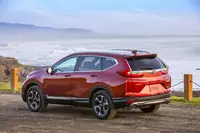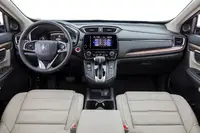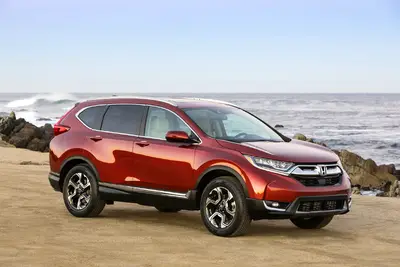Car Review: 2017 Honda CR-V 1.5T AWD Touring by Carey Russ +VIDEO
Major changes to chassis and powertrain keep Honda’s ever-popular CR-V compact crossover at the head of the class
DRIVING DOWN THE ROAD WITH CAREY RUSS
• SEE ALSO: Honda Research and Buyers Guide
 |
Compact crossovers are hot items at all levels in the automotive marketplace, from entry to luxury. Honda is positioned well to fight the competition, with its all-new fifth-generation CR-V. That term is over-used, but not here — the 2017 CR-V is built on a new chassis platform and, in its upper trim levels, sees its first turbocharged engine.
Turbo CR-V?!? Don’t be thinking CR-V Si or anything like that here. “Performance” in the crossover SUV field relates more to cargo and passenger carrying ability, potential use on fire and forest roads, and towing than acceleration and cornering. And the 1.5-liter turbo engine found in the EX, EX-L, and Touring seems on paper to be little improvement over the carryover 2.4-liter naturally-aspirated one in the LX as torque and horsepower figures are similar. The 2.4 makes a maximum of 180 lb-ft of torque at 3900 rpm, with horsepower peaking at 184 at 6400 rpm. The 1.5 turbo makes 179 lb-ft from 2000 through 5000 rpm, with peak horsepower 190 at 5600 rpm. Both run on unleaded regular and transmit that to the front or all wheels via a continuously-variable transmission (CVT).
Which means that rarely if ever will revs be at peak horsepower, and midrange torque is king. The turbo’s broad torque curve means less virtual shifting, quicker response to driver desires, and potentially better fuel economy. EPA ratings are two mpg better for the turbo for city, highway, and combined. If that doesn’t seem like much, multiply by the number of CR-Vs sold — it’s been the most popular SUV since its debut twenty years ago — and there’s the logic.
More apparent than what’s under the new CR-V’s hood is its hood, and the rest of its exterior styling. While there’s plenty of continuity for immediate identification, the `17 CR-V is sleeker and more aerodynamically efficient (better fuel economy and stability) and a bit larger. To the tune of 1.2 inches in length, 1.4 in both width and height, and with the wheelbase stretched 1.6 inches for improved ride comfort and interior space. Yes, it’s bigger, heavier, and more powerful than ever, but a quick glance back in my records reveals a surprise: The 1999 EX AWD I tested got 23 mpg, with a 0-60 time around 10 seconds. This week’s Touring AWD got 28 mpg, with a 0-60 time around 7.6 seconds. And is a more comfortable and capable vehicle. Towing ability is up as well, from 1000 to 1500 pounds. Yes, as always, the CR-V is more car than truck — and few people have a problem with that.
No surprise there. In top-level Touring AWD trim, the CR-V is as well-equipped and appointed as a luxury car from the not very distant past, with leather seating, power-assisted everything except steering wheel adjustment, and electronic infotainment, connectivity, and safety features that didn’t exist when leather and power windows meant luxury. No, that’s not real wood inside. So? With space for four real adults plus a medium-sized third passenger in the back, plenty of cargo capacity and versatility — and useful official attachments for carrying more outside plus trailering and even a tailgate tent — and the best fuel economy of any non-hybrid compact crossover, it’s no surprise that the Honda CR-V is still at the head of its class.
APPEARANCE: It’s instantly recognizable as a Honda CR-V, but more defined and assertive thanks to the reshaped grille, front bumper fascia, and hood and simpler, crisper side panels. Thinner roof pillars and reshaped side windows bring more light inside, and a more mainstream look outside. Ground clearance is up an inch and a half, to 8.2 inches — almost the same as the original’s 8.1. The rear panel is more vertical than before, adding a bit of storage space. All trim levels have LED taillights, turn signals, and brake lights; the Touring gets LED headlights and standard roof rails as well. And yes, the taillights still reach up the sides of the tailgate.
 |
COMFORT: More is better, especially for interior space. There’s not that much more — 1.8 cubic feet of passenger volume, 2.0 more cargo volume with the rear seats up or 4.9 with them down, and fractional amounts of head, leg, and hip room (but two inches more rear legroom). That’s enough so that no one inside will feel cramped, and there is plenty of space for people and stuff in various combinations. Interior styling is more conservative than the exterior, and features high-quality materials and fit and finish. EX and above get a bright TFT Driver Information Interface instead of analog gauges, with analog tach, digital speedometer, and programmable other information. The steering wheel has controls for cruise, audio, phone, and information systems, useful since the virtual control buttons on the touchscreen on the center stack are on the small side. Analog climate system controls are under that, and the shift lever is in its usual position for a CR-V, in a lower extension of the center stack. The Touring has leather shift knob and steering wheel rim, and leather seating, heated and power-adjustable in front, and with a 60/40 folding rear contoured bench. A near-flat floor and the extra width make the center position a reasonable place, unlike in some small crossovers and sedans. Rear seat climate system ducts are found in all models. Interior storage is good, with a large console box, locking glovebox, and storage and bottle holders in all doors. A space-saver spare is found under the load floor.
SAFETY: In addition to the usual (and mandated) airbags, safety harnesses, and crumple zones, and good four-wheel antilock disc brakes with brake assist and electronic brake-force distribution, the new CR-V can be had with nearly every current electronic safety system. Honda Sensing™ is standard in all but the LX and consists of adaptive cruise control with low-speed follow and Collision-Mitigating Braking, Forward Collision Warning, Lane-Departure Warning, Road Departure Mitigation, and Lane-Keep Assist systems. EX and above also gets a blind-spot information system and driver attention monitor. All CR-Vs have a multi-angle rearview camera.
RIDE AND HANDLING: The extensive use of high-strength and ultra-high strength steel that contributes to safety and visibility also means a stronger, more rigid unibody structure. A slightly longer wheelbase and greater track than before improve stability and interior space. That and the supple and well-damped fully-independent MacPherson strut/multilink suspension give it good manners on the road and good behavior in strong winds. The electrically-assisted power steering is not over-assisted or too numb, for a more enjoyable driving experience than the norm for small crossovers. Active handling assist in the form of brake torque vectoring, with inside brakes applied when initiating a turn, further improves control.
PERFORMANCE: As mentioned, the 1.5-liter turbocharged and intercooled four cylinder engine in the upper trim levels of the new CR-V is meant to sip fuel while providing useful power. Honda discovers torque! It’s a modern high-tech power unit, featuring lightweight aluminum alloy construction, dual overhead cams actuating four valves per cylinder with variable phasing of both intake and exhaust for optimum efficiency, direct fuel injection for further efficiency, and intercooled turbocharging for yet more efficiency. Efficiency meaning clean power on a minimal amount of fuel — unleaded regular in this case. It’s related to the turbo engine found in some new Civics, but has a lower compression ratio and higher boost from a revised turbocharger. The result is 190 horsepower (at 5600 rpm), with 179 lb-ft of torque from 2000 through 5000 rpm. The Civic turbo has 174 hp and 162 lb-ft. It matches well to the CVT, with everything computer-controlled and three different driving modes. The normal default works well enough, with Econ for fuel-sipping (lower revs and less throttle response) and Sport for when you want to get there, with quicker throttle response and revs kept higher. Any “turbo lag” felt is more likely from the transmission, and it’s never a problem given the mission of the CR-V. It’s not an Si or Type R… That said, it’s quick enough to deal with traffic and even when kept mostly in Sport mode and off of long boring highway stretches, as during my week, frugal with fuel. If my 28 mpg average was a bit lower than the EPA estimates, I wasn’t driving for fuel economy.
CONCLUSIONS: Major changes to chassis and powertrain keep Honda’s ever-popular CR-V compact crossover at the head of the class.
SPECIFICATIONS
2017 Honda CR-V 1.5T AWD Touring
Base Price $ 33,695
Price As Tested $ 34,595
Engine Type turbocharged and intercooled DOHC 16-valve inline 4-cylinder with variable valve lift and cam phasing and direct fuel injection
Engine Size 1.5 liters / 91 cu. in.
Horsepower 190 @ 5600 rpm
Torque (lb-ft) 179 @ 2000-5000 rpm
Transmission CVT
Wheelbase / Length 104.7 in. / 180.6 in.
Curb Weight 3512 lbs.
Pounds Per Horsepower 18.5
Fuel Capacity 14 gal.
Fuel Requirement 87 octane unleaded regular gasoline
Tires 235/60R18 103H m+s Hankook Kinergy GT
Brakes, front/rear vented disc / solid disc, ABS, EBD, BA standard
Suspension, front/rear independent MacPherson strut / independent multi-link
Ground Clearance 8.2 inches
Drivetrain transverse front engine, automatic all-wheel drive
PERFORMANCE
EPA Fuel Economy - miles per gallon city / highway / observed 29 / 33 / 28
0 to 60 mph 7.6 sec
Towing Capacity 1500 lbs.
OPTIONS AND CHARGES
Destination Charge $ 900



